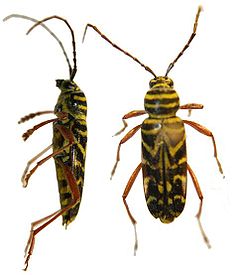Megacyllene robiniae
| Megacyllene robiniae | |
|---|---|

| |
| Adult locust borer | |
| Scientific classification | |
| Kingdom: | |
| Phylum: | |
| Class: | |
| Order: | |
| Suborder: | |
| Superfamily: | |
| Family: | |
| Subfamily: | |
| Tribe: | |
| Genus: | |
| Species: | M. robiniae
|
| Binomial name | |
| Megacyllene robiniae (Forster, 1771)
| |
| Synonyms | |
Megacyllene robiniae, commonly known as the locust borer, is a species of longhorn beetle endemic to eastern North America. It is a serious pest of Robinia pseudoacacia, the black locust tree, with which it is sympatric.
Etymology
The specific name, robiniae, is derived from the name Robinia, which is the generic name of the black locust tree, Robinia pseudoacacia, on which the larvae feed. The name Robinia was coined by Linnaeus to honor the royal French gardeners Jean Robin (father) and Vespasien Robin (son).
Description
From a distance, M. robiniae can easily be mistaken for a wasp or bee. Even at a closer look, it is often mistaken for M. caryae or M. decora. The adult beetle grows between 12 and 20 mm (0.47 and 0.79 in) long and has a W-shaped third stripe on the elytra. The antennae of both sexes are dark brown. The male's antennae are two-thirds its body length, and the female's are one-half. The legs are reddish brown.
Geographic range and habitat
Its geographic range has grown over the years following the expanding range of R. pseudoacacia. As more and more people use the black locust tree as an ornamental, the range of M. robiniae grows. It can be found almost anywhere unprotected black locust trees grow, and is often more abundant when Solidago, commonly called goldenrod, is also present. Because of the adults' floral preferences, they tend to stay in uncultivated fields and meadows.
Lifecycle and diet

The females are often found running up and down black locust trunks in search of wounds in which to lay their eggs in the fall. Both sexes are most common from late day to dusk. Adults feed on pollen of goldenrods of the genus Solidago. The eggs hatch and the larvae spend the winter hibernating within the bark. Once winter ends, the larvae burrow into the tree trunk and start to tunnel. These tunnels are around 10 cm (3.9 in) long by 7 mm (0.28 in) wide, and serve as a primary infection site for wind-borne spores of the fungus Phellinus robiniae, which causes a damaging heart rot disease of Robinia species. The larvae pupate in late July and early August, and adults start to emerge in late August and throughout September.
Pest status
In 1900, the value of Robinia pseudoacacia was reported to be practically destroyed in nearly all parts of the United States beyond the mountain forests which are its home by M. robiniae. Were it not for these beetles and their larval tunnels promoting fungal infections, it could be one of the most valuable timber trees that could be planted in the northern and middle states; young trees grow quickly and vigorously for a number of years, but soon become stunted and diseased, and rarely live long enough to attain any commercial value.[1] Currently, only one registered product, carbaryl, is effective against M. robiniae. It is applied in a single dose when adults are most active (August/September).[2]
References
- ^ Keeler, Harriet L. (1900). Our Native Trees and How to Identify Them. New York: Charles Scriber's Sons. pp. 97–102.
- ^ "Locust Borer Megacyllene robiniae (Forster)". Retrieved 2008-12-18.
- "Species Megacyllene robiniae - Locust Borer - Bugguide.net". Retrieved 2008-12-18.
- "ITIS (Integrated Taxonomic Information System) Standard Report Page: Megacyllene robiniae". Retrieved 2008-12-18.
- Kaufman, Kenn; Eaton, Eric R. (2006). Kaufman Field Guide to Insects of North America. Boston: Houghton Mifflin Books. pp. 180–181. ISBN 978-0-618-15310-7.
- Sinclair, Wayne A.; Lyon, Howard H. (2005). Diseases of Trees and Shrubs, 2nd Edition. Ithaca: Cornell University Press. ISBN 978-0-8014-4371-8.
- Milne, Lorus; Milne, Margery (1980). National Audubon Society Field Guide to North American Insects & Spiders. New York: Alfred A. Knopf, Inc. p. 594. ISBN 0-394-50763-0.
- Evans, Arthur V. (2007). "Beetles, Order Coleoptera". Field Guide to Insects and Spiders of North America. New York: Sterling Publishing Co., Inc. p. 207. ISBN 978-1-4027-4153-1.
